
Art may have its periods of decadence, but it is everlasting like life itself.← Back
Fyodor Ivanovich Shalyapin, Opera Singer (1873-1938)
Vassily POLENOV - Moscow Сourtyart
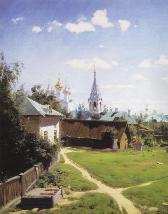
Do you recognize this picture? A courtyard with low buildings, trails, churches in the distance, summery clear skies. Everything is so dear, so familiar. But something seems to be missing…
Do you recognize this picture? A courtyard with low buildings, trails, churches in the distance, summery clear skies. Everything is so dear, so familiar. But something seems to be missing…
That’s it! There are missing people who would make the image lively. Indeed this is a study to the best known work of Vassily Dmitrievich Polenov (1844-1927) “Moscow courtyart”. And in the picture a very important role belongs to the living creatures – kids at the front, a bit further – a woman carrying a bucket of water, chicken and a cock, a harnessed horse. Every Russian starting from early school age knows well and adores this painting situated in the Tretyakov gallery. And meanwhile not many know the story of its creation, which is worth learning.
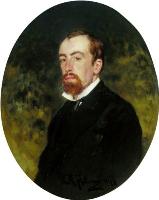 |
| Repin. Portrait of Vasily Polenov |
June 1877. A young painter Vassily Polenov, born in Petersbirg, came back to Russian after a pensionner’s travel across Europe which was granted to him together with a Golden medal by The Imperial Academy of Arts for accomplishing his diploma work. Polenov spent 4 years abroad, there he met the already notorious Russian writer I.S.Turgenev (1818-1883) who had settled not far from Paris, and became friends with Ilya Repin and Viktor Vasnetsov, same age as Polenov and graduates as himself of the same Saint-Petersburg Fine Arts Academy. Upon a longed for return to his native country the painter decided to settle in Moscow.
While looking for an apartment to rent he came by a house in the Arbat area close to the church Spas-na-Peskah. He later recalled: “I searched for an apartment. Saw a note on the door, came in to take a look, and straight from the window I saw this view, so I sat down and painted it right away”. Imagine this, he only just agreed upon the price with owner and before unpacking his suitcase, the first thing he did was sit down to paint this view! (Later Polenov will paint several more studies from his window, including in water-colour. One of the author’s repetitions of this study, dated 1902, is preserved in the State Russian Museum in Saint-Petersburg, other works are in private collections.)
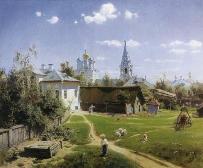 |
| Polenov. Moscow courtyard. 1878. Oil on canvas. Tretyakov Gallery in Moscow |
A year later, based on the original study, Polenov will create his famous painting which he will prepare especially for the sixth Peredvizhny exhibition that opened in Moscow May 7, 1878. Making a big painting from his study Polenov wasn’t at all sure if this work would be worth the public’s attention. Here is what he wrote to his older colleague, one of the founders of the Association of Travelling Art Exhibits, Ivan Nikolayevich Kramskoi: “Unfortunately I haven’t had the time to produce a more important work than that. I meant to participate in the peredvizhny exhibition with something more decent. I hope in the future to compensate for the arts the time that I’ve lost”…
This self-criticism is even more curious given that “Moscow courtyard” absolutely enchanted the visitors as well as the other participants in the exhibition and it was promptly acquired by Pavel Mikhaylovich Tretyakov – the far-famed Russian collector. Four years later Tretyakov will donate his fine arts gallery (about 2000 works of art, including Polenov’s “Moscow courtyard”) to the city of Moscow.
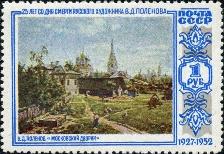 |
| USSR Stamp. 1952 |
Nowadays the Tretyakov gallery is the holder of the painting as well as the study for it. The difference between the original study and the painting is first of all the size – from 49х38 cm it has grown to 65x80 cm. Polenov stretched horizontally the vertical study, so that the composition can include one more church and a white mansion. Also, if you look closely, you will notice that the painter changed a bit the angle of view. But what catches one’s eye the most is the genre element – Polenov populated his painting with charming personages. And their positioning in the composition only seems to be random, in the reality it has been carefully thought over.
As for the pictorial characteristics, striking as it is, the final painting is even more airy, luminous, plein-air style. Such a result is rare in arts. More often we see studies that reflect much better the artist’s first impression and it is harder for the painter to repeat the same effect in a painting. Here it is the opposite. In the finished painting indeed Polenov managed to reproduce the freshness of the morning, the hot June sunshine, a typical town courtyard atmosphere. Cock has sung, people have woken up, bells have rung, and the everyday life is starting its swirl.
Generally the theme of interplay between man and nature is very important for Polenov, and “Moscow courtyard” was a turning point in his career. This work is the proof that he has chosen the right path. Indeed still being a pensioner in France he concluded “that my talent is closest to genre landscape which I mean to take up”.
This painting served as an entrance ticket for Polenov to the Association of Travelling Art Exhibits. Polenov wanted to join Peredvizhniki for a long time now, because all his “sympathy were with the association from its very beginnings”. The new pals celebrated Polenov’s success. For many of his colleagues and for the critics “Moscow courtyard” was a revelation. All praised “a corner à la Tourgenev” as the Polenov himself called it.
It is interesting to know that on of the “unpeopled” studies – namely the very first author’s repetition painted by Polenov from the same window – the artist presented to Ivan Sergeyevich Turgenev in 1880 when the latter, not long before his death, came to Moscow to assist at the opening of the A.S.Pushkin monument. The study of the Moscow courtyard hang at Tourgenev’s home in Boujival till his very decease and reminded the very ill writer about his far-away homeland.
 |
| Modernisation of Polenov's courtyard by designer Sergei Sintsov. 2008. |
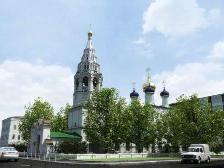 |
| Church of Spas Preobrazhenia na Peskah (view today) |
This is an old story. This house, where Polenov painted this study, doesn’t exist anymore. Before this house stood in Durnovsky pereulok, neighboring the today’s Kompozitorskaya Street. Now this is the corner of Kamennaya Sloboda and Trubnikovsky pereulok (between Old Arbat and New Arbat streets, closer to Sadovyi ring). But the Church of Spas Preobrazhenia na Peskah, painted by the artist, is still there. Will it stand for a long time, with all the Moscow building up speeds? It would certainly be a pity if this church stays only on Polenov’s poetic painting, and on such collage works of contemporary designers.

